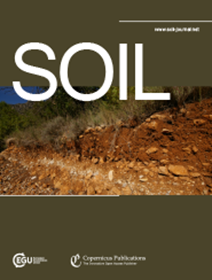Improving the relationship between soil texture and large-scale electromagnetic induction surveys using a direct current electrical resistivity calibration
IF 5.8
2区 农林科学
Q1 SOIL SCIENCE
引用次数: 0
Abstract
Abstract. Ground-based electromagnetic induction (EMI) surveys can be used to infer soil properties and (by extension) support nutrient loss risk assessments of agricultural fields. The transport of nutrients from an agricultural field to surrounding surface waters depends on the hydrologic connectivity between the two systems, largely controlled by soil texture. Preexisting soil texture maps and associated soil drainage classifications are often used as proxy information to assess the potential for lateral migration of nutrients in the groundwater; however, the resolution of these maps is inadequate at the scale of individual fields. In this study, we evaluated whether the relationship between EMI data and soil texture was improved by calibrating the apparent electrical conductivity measured by an EMI sensor with a 2D electrical resistivity imaging (ERI) survey. The joint geophysical survey was performed across a ~1-ha field in Princess Anne, Maryland, United States. A calibration-inversion-comparison framework is presented that calibrates the EMI measurements using ERI conductivity models and subsequently inverts the EMI data. A robust validation scheme compared the calibrated and not calibrated EMI conductivity models against grain size, core-scale conductivity measurements and an ERI survey performed roughly 80 m from the first. This study shows that the calibration of EMI data with an ERI profile is significantly improves the quantitative relationship between EMI-derived electrical conductivity and representative soil properties, ensuring a finer-resolution proxy soil map for evaluating subsurface nutrient transport from agricultural fields.利用直流电阻率定标改善土壤质地与大尺度电磁感应测量的关系
摘要。地面电磁感应(EMI)调查可用于推断土壤性质,并(进一步扩展)支持农田养分损失风险评估。从农田到周围地表水的养分运输取决于两个系统之间的水文连通性,这在很大程度上由土壤质地控制。先前存在的土壤质地图和相关的土壤排水分类经常被用作评估地下水中营养物质横向迁移潜力的代理信息;然而,这些地图的分辨率在单个领域的规模是不够的。在这项研究中,我们通过将电磁干扰传感器测量的视电导率与二维电阻率成像(ERI)调查进行校准,评估了电磁干扰数据与土壤质地之间的关系是否得到改善。联合地球物理测量在美国马里兰州安妮公主区约1公顷的土地上进行。提出了一个校准-反演-比较框架,该框架使用ERI电导率模型校准电磁干扰测量,随后反演电磁干扰数据。一个强大的验证方案将校准和未校准的EMI电导率模型与晶粒尺寸、岩心尺度电导率测量和距离第一次大约80米的ERI调查进行了比较。该研究表明,利用ERI剖面对EMI数据进行校准可以显著改善EMI衍生电导率与代表性土壤特性之间的定量关系,确保获得用于评估农田地下养分运输的更精细分辨率代理土壤图。
本文章由计算机程序翻译,如有差异,请以英文原文为准。
求助全文
约1分钟内获得全文
求助全文
来源期刊

Soil
Agricultural and Biological Sciences-Soil Science
CiteScore
10.80
自引率
2.90%
发文量
44
审稿时长
30 weeks
期刊介绍:
SOIL is an international scientific journal dedicated to the publication and discussion of high-quality research in the field of soil system sciences.
SOIL is at the interface between the atmosphere, lithosphere, hydrosphere, and biosphere. SOIL publishes scientific research that contributes to understanding the soil system and its interaction with humans and the entire Earth system. The scope of the journal includes all topics that fall within the study of soil science as a discipline, with an emphasis on studies that integrate soil science with other sciences (hydrology, agronomy, socio-economics, health sciences, atmospheric sciences, etc.).
 求助内容:
求助内容: 应助结果提醒方式:
应助结果提醒方式:


